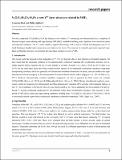Files in this item
V2O2F4(H2O)2·H2O: a new V4+ layer structure related to VOF3
Item metadata
| dc.contributor.author | Black, Cameron | |
| dc.contributor.author | Lightfoot, Philip | |
| dc.date.accessioned | 2016-01-25T15:40:02Z | |
| dc.date.available | 2016-01-25T15:40:02Z | |
| dc.date.issued | 2016-01 | |
| dc.identifier | 240325520 | |
| dc.identifier | 61e7b692-9dfc-48e5-90ae-9bec0b1c64bf | |
| dc.identifier | 84954323723 | |
| dc.identifier | 000367827500013 | |
| dc.identifier.citation | Black , C & Lightfoot , P 2016 , ' V 2 O 2 F 4 (H 2 O) 2 ·H 2 O: a new V 4+ layer structure related to VOF 3 ' , Acta Crystallographica Section C: Crystal Structure Communications , vol. 72 , no. 1 , pp. 80-83 . https://doi.org/10.1107/S2053229615024122 | en |
| dc.identifier.issn | 0108-2701 | |
| dc.identifier.other | ORCID: /0000-0001-7048-3982/work/59464490 | |
| dc.identifier.uri | https://hdl.handle.net/10023/8077 | |
| dc.description | The authors thank EPSRC for a DTA studentship (EP/P505097/1) to CB. | en |
| dc.description.abstract | The title compound, V2O2F4(H2O)2·H2O, (I), features a new infinite, V4+-containing, two-dimensional layer, comprised of fluorine bridged corner-sharing and edge-sharing VOF4(H2O) octahedral building units. Synthesis was carried out under solvothermal conditions. The V4+ centre exhibits a typical off-centring, with a short V=O bond and elongated trans V—F bond. Hydrogen bonded water molecules occur between the layers. The structure is related to previously reported vana- dium oxyfluoride structures, in particular the same layer topology is seen in VOF3. | |
| dc.format.extent | 175693 | |
| dc.language.iso | eng | |
| dc.relation.ispartof | Acta Crystallographica Section C: Crystal Structure Communications | en |
| dc.subject | V4+ layer structure | en |
| dc.subject | VIV oxyfluorides | en |
| dc.subject | Frustrated magnets | en |
| dc.subject | Crystal structure | en |
| dc.subject | Ionic liquids | en |
| dc.subject | Fluorine bridging | en |
| dc.subject | Solvothermal conditions | en |
| dc.subject | QD Chemistry | en |
| dc.subject | DAS | en |
| dc.subject.lcc | QD | en |
| dc.title | V2O2F4(H2O)2·H2O: a new V4+ layer structure related to VOF3 | en |
| dc.type | Journal article | en |
| dc.contributor.institution | University of St Andrews. School of Chemistry | en |
| dc.contributor.institution | University of St Andrews. EaSTCHEM | en |
| dc.identifier.doi | https://doi.org/10.1107/S2053229615024122 | |
| dc.description.status | Peer reviewed | en |
This item appears in the following Collection(s)
Items in the St Andrews Research Repository are protected by copyright, with all rights reserved, unless otherwise indicated.

